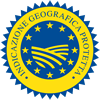Description
Raviole du Dauphiné PGI are a regional speciality that come in the form of small thin squares of pasta with a soft wheat flour base with a very low ash content (wheat germ), water, fresh eggs and vegetable oil. The stuffing is composed of fresh fromage blanc made with cow's milk, hard pressed cheese (Comté PDO and/or Emmental français Est-Central PGI), salt and parsley browned in butter.
Production Area
Raviole du Dauphiné PGI is produced in some of the municipalities of the Drôme department and of the Isère department in the Rhône-Alpes region.
Production Method
Raviole du Dauphiné PGI are made by kneading the dough, mixing the stuffing and filling the dough with the stuffing. Two sheets of dough (one for the top and one for the bottom) are rolled out thin and joined together before being filled with the stuffing. The process is very quick and is followed by placing the dough into a mould to give it the distinct shape of ravioles.
Appearance and Flavour
The product has succulent, thin pasta and soft, creamy stuffing, characterised by a balance between the flavour of the parsley and the cheeses.
History
The first texts that mention the raviole in the Dauphiné region go back to 1228. The many different culinary dishes from the Dauphiné countryside are made using only products from the land, hence the use of cheeses in the ravioles instead of meat, unlike other types of pasta. The raviole was a local culinary dish, a traditional family meal, initially eaten in days of fasting and subsequently eaten both on civil and religious holidays. It became more widespread at the beginning of the 20th century, when ravioleuses- women who make the product - would travel from farm to farm to make some the night before a party. The recipe that is used today for Raviole du Dauphiné became established in the 19th century and the invention of the ravioles machine led to increased production of the product and enabled it to become more widespread. The Raviole du Dauphiné PGI are considered part of the culinary heritage of the Dauphiné and a particularity of this region.
Gastronomy
Raviole du Dauphiné PGI is best kept in a cool and dry place and in the case of the frozen product it should be kept in the freezer. The product is unique in that the thin soft wheat-based dough takes just one minute to cook in boiling water. Its thin pasta and cheese-based stuffing - distinguishing and unique characteristics - won Raviole du Dauphiné PGI the approval of many chefs who consider it to be "a real delight to the palate with a miraculous taste". Raviole du Dauphiné can therefore be found in a large number of local recipes: ravioles en gratin, fried ravioles with salad, ravioles à la crème, morel ravioles, crayfish ravioles, etc.
Marketing
The product is sold as Raviole du Dauphiné PGI. The Raviole du Dauphiné PGI come fresh, packed in a controlled atmosphere or unpacked, or frozen. They are sold in sheets of 48 precut pieces when fresh and in separate pieces when frozen. Each sheet weighs between 60 and 65 gr, which is the equivalent of between 1 and 1,5 gr per square.
Distinctive Features
The Raviole du Dauphiné PGI are made using ingredients of the highest quality without artificial colouring or preservatives or any product to add texture. The particularity of the product is that the thin soft wheat-based dough takes just one minute to cook in boiling water.





